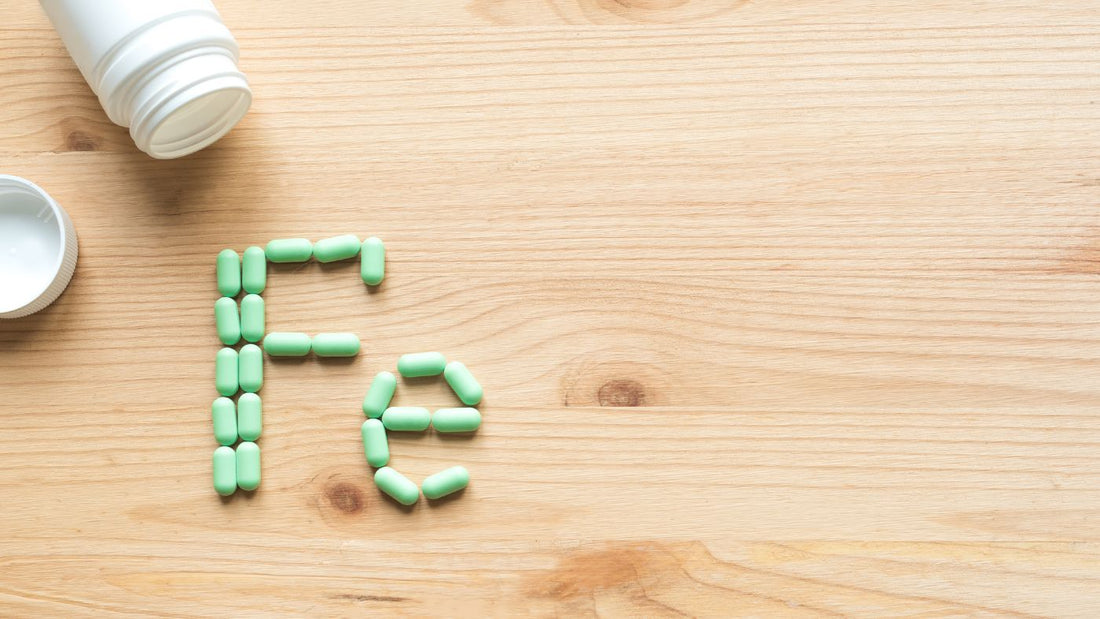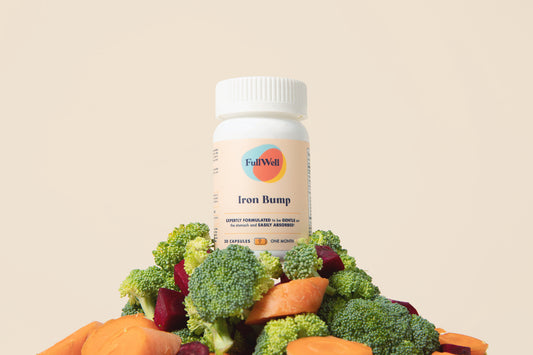Vitamin C: Myth vs. Reality
Read more

Iron is one of the most common topics I address through email and DM, and for good reason! It’s a vital mineral for growth and development, especially when trying to conceive and during pregnancy. Monitoring and adjusting iron levels is key, as both your health and your baby’s development rely on it.
That said, the number one question I receive has to do with the fact that our Women’s Prenatal, well, doesn't contain any iron.
Our Women’s Prenatal does not have iron in it by design. Let me explain.
Iron needs and tolerances vary widely among individuals, and as your pregnancy progresses, your body’s iron requirements change, making it crucial to ensure you’re getting enough for your health at every stage. However, not all women need supplements; many can meet their iron needs through diet alone, which makes me extremely happy as a real food dietitian!
For those needing iron supplements, it's best to match the form and dose to your individual needs. Working with your healthcare practitioner to monitor your iron status ensures you get the right form and dosage, helping to prevent digestive issues, avoid nutrient absorption interference, and ensure you're not over- or under-supplementing.
I didn’t leave iron out of our Women’s Prenatal because it’s not important. In fact, it’s so important that it needs to be managed separately from your comprehensive prenatal multivitamin to make sure you’re getting exactly what you need (which is why I created Iron Bump!).
Iron is crucial for making healthy blood and carrying oxygen to your body's tissues.* It's essential at all life stages, especially during pregnancy, when your blood volume almost doubles.
Iron also helps with supporting normal thyroid hormone production, growing the placenta, and managing energy.* Babies need it for brain development and a healthy birth weight.* So, iron is a big deal! But it's not meant to be in your prenatal multivitamin.
To learn more about iron needs through the stages (preconception, pregnancy trimesters and postpartum), check out our blog post here.
Iron is used to create:
Your body absorbs iron from food through the small intestine and uses a protein called transferrin to distribute it throughout your body. About 70% (1) of iron helps create hemoglobin, which carries oxygen, while the rest is stored as ferritin, a safe iron reserve. This helps prevent iron overload and protects your organs from potential damage caused by excessive iron levels.
The National Institutes of Health (2) recommends roughly 18 mg of iron per day for non-pregnant women, 27 mg per day for pregnant women, and 9 mg per day for lactating women. Even before pregnancy, deficiency is common for various reasons, including diet. Many women adhere to specific diets that, by nature, lack sufficient iron, putting them at a much greater risk for iron deficiency.
According to the World Health Organization, the global prevalence of anemia (when your body doesn’t have enough healthy red blood cells to carry oxygen to your organs and tissues) in 2019 was 29.9%, which means over half a billion women between the ages of 15-49 are affected (3). Breaking this down further, they found the prevalence of anemia in non-pregnant women of reproductive age to be 29.6%, and 36.5% in pregnant women (3).
There are two main types of iron you can get from your diet: heme iron and nonheme iron.
Heme iron, primarily found in animal proteins, is highly bioavailable, meaning it's absorbed quickly and efficiently by your body (about 25-40%).
Nonheme iron, found in plant-based foods, is absorbed at a much lower rate (2-13%). Since nonheme iron is harder for your body to absorb, it takes longer before it can be used effectively.
To get the amount of iron you need even before pregnancy without consuming meat, you’d have to eat truly enormous volumes of these foods even to have a shot at absorbing enough iron. And while many foods, like cereals, are fortified (4) with iron, it is understood that this iron is not only very poorly absorbed but often leads to digestive discomfort, which we are trying to avoid at all costs!
One thing that can help plant-sourced nonheme iron become more bioavailable is to eat it with another food that is high in vitamin C (5) (e.g., bell peppers, citrus, strawberries, tomatoes, etc.).
Iron needs an acidic environment in your gut to be absorbed properly, and vitamin C helps create that environment. However, it's important to note that vitamin C-rich foods fortified with calcium, such as many orange juices, should be avoided when consumed alongside iron-rich foods, as calcium can inhibit iron absorption (6).
There are a handful of additional compounds that can also inhibit iron absorption (7), including:
When we consume and absorb too much iron, our body employs a safeguard to protect us from overdoing it.
Hepcidin, a hormone produced by the liver, serves as a gatekeeper that regulates the movement of iron in and out of cells. When iron levels are high, hepcidin production increases, which reduces the absorption of iron from food and supplements while limiting the release of stored iron from ferritin, helping to prevent iron overload.
In contrast, when iron levels are low, hepcidin decreases its production, allowing for greater iron absorption from the diet and more release from ferritin for the body to use.
Poor dietary intake aside, iron deficiency is common in women with heavy menstrual periods, as blood loss and insufficient iron-rich foods can deplete iron levels before pregnancy.
Gastrointestinal disorders like celiac disease, inflammatory bowel disease or procedures like gastric bypass or gallbladder removal can also lead to iron deficiency due to poor absorption.
While mild iron deficiency isn't alarming and can be managed with diet and supplements, if left unchecked, it can progress to iron deficiency anemia.
Symptoms of anemia include extreme fatigue, weakness, shortness of breath, chest pain, erratic heartbeat, dizziness, and poor appetite.
Your iron status has three stages: iron depletion (depleted stores but no impact on blood cells yet), iron deficiency (low stores affecting red blood cell production), and iron deficiency anemia (reduced oxygen supply to tissues).
Early detection is crucial for replenishing iron stores before symptoms like fatigue occur. While this gives you time to correct a deficiency, it also means you might not realize you're at risk unless you’ve had your labs tested.
Iron labs can be really confusing and overwhelming, especially if you're just starting out with assessing your iron status. With so many different tests available, it’s easy to feel like you need to dive straight into a full panel.
But the good news is, you don’t have to. It’s possible to get a good sense of where your iron levels stand by starting with just one or two key tests, and then building from there if needed.
Let’s break down the most important ones and how to prioritize them.
Typically hemoglobin and hematocrit are taken as part of your standard prenatal care.
If you’re looking for a basic understanding of your iron status, ferritin is the best indicator of iron stores.
If you're concerned about iron status, starting with ferritin gives you the most insight into early deficiency, while adding transferrin saturation and hemoglobin/hematocrit rounds out the picture for a fuller assessment.
At a minimum, retest your iron levels 1-2 months after beginning supplementation. This helps ensure that your anemia or iron lab values are improving, and allows treatment to be adjusted as needed.
Remember to communicate with your healthcare practitioner about whether or not they’d like you to avoid iron supplements for a certain period before the test, typically 24 to 48 hours, to allow your iron levels to stabilize and provide a more accurate reflection of your iron status.
Once your lab results come back, your healthcare practitioner will help you determine what is right for you depending on which stage of your pregnancy you are in or where your lab results fall.
When it comes to iron supplements, there are two key must-haves you should be on the lookout for.
Iron supplements can come in many forms including ferrous sulfate, ferric citrate, ferric sulfate, ferrous gluconate, ferrous bisglycinate, etc.
There is one form of iron that is not only bioavailable but also associated with fewer digestive side effects: iron bisglycinate. In most cases, a 25mg daily dose of iron bisglycinate (8) has been shown to be as effective in preventing iron deficiency and iron deficiency anemia in pregnancy as the more common (but more difficult to tolerate) form of iron, ferrous sulfate (9).
Iron bisglycinate has also been shown to be a better option than conventionally used iron salts as it has at least two-fold higher bioavailability and absorption with fewer digestive side effects (10).
Iron Bump isn't just a supplement; it's a solution meticulously created for those who struggle to maintain optimal iron levels. We've harnessed the power of iron bisglycinate, a gentle on-the-stomach and non-constipating form of iron, to ensure better tolerance and compliance.* Our innovative formula also contains vitamin C from acerola cherries in a well-studied 2:1 ratio, plus our digestive comfort blend of whole food nutrients to help with digestive ease.*
